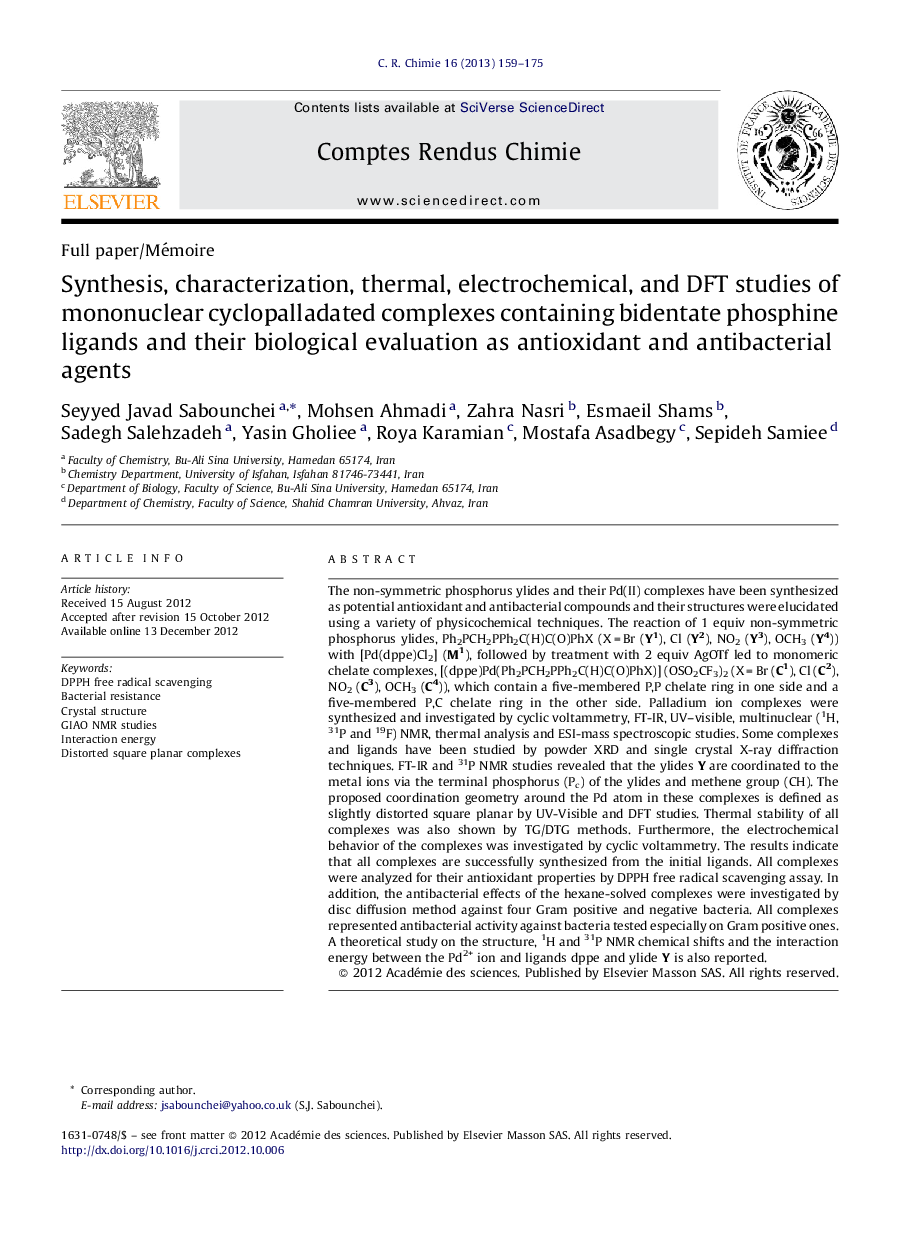| کد مقاله | کد نشریه | سال انتشار | مقاله انگلیسی | نسخه تمام متن |
|---|---|---|---|---|
| 170888 | 458421 | 2013 | 17 صفحه PDF | دانلود رایگان |

The non-symmetric phosphorus ylides and their Pd(II) complexes have been synthesized as potential antioxidant and antibacterial compounds and their structures were elucidated using a variety of physicochemical techniques. The reaction of 1 equiv non-symmetric phosphorus ylides, Ph2PCH2PPh2C(H)C(O)PhX (X = Br (Y1), Cl (Y2), NO2 (Y3), OCH3 (Y4)) with [Pd(dppe)Cl2] (M1), followed by treatment with 2 equiv AgOTf led to monomeric chelate complexes, [(dppe)Pd(Ph2PCH2PPh2C(H)C(O)PhX)] (OSO2CF3)2 (X = Br (C1), Cl (C2), NO2 (C3), OCH3 (C4)), which contain a five-membered P,P chelate ring in one side and a five-membered P,C chelate ring in the other side. Palladium ion complexes were synthesized and investigated by cyclic voltammetry, FT-IR, UV–visible, multinuclear (1H, 31P and 19F) NMR, thermal analysis and ESI-mass spectroscopic studies. Some complexes and ligands have been studied by powder XRD and single crystal X-ray diffraction techniques. FT-IR and 31P NMR studies revealed that the ylides Y are coordinated to the metal ions via the terminal phosphorus (Pc) of the ylides and methene group (CH). The proposed coordination geometry around the Pd atom in these complexes is defined as slightly distorted square planar by UV-Visible and DFT studies. Thermal stability of all complexes was also shown by TG/DTG methods. Furthermore, the electrochemical behavior of the complexes was investigated by cyclic voltammetry. The results indicate that all complexes are successfully synthesized from the initial ligands. All complexes were analyzed for their antioxidant properties by DPPH free radical scavenging assay. In addition, the antibacterial effects of the hexane-solved complexes were investigated by disc diffusion method against four Gram positive and negative bacteria. All complexes represented antibacterial activity against bacteria tested especially on Gram positive ones. A theoretical study on the structure, 1H and 31P NMR chemical shifts and the interaction energy between the Pd2+ ion and ligands dppe and ylide Y is also reported.
Four synthesized palladium(II) complexes, [(Ph2PCH2CH2PPh2)Pd(Ph2PCH2PPh2C(H)C(O)PhX)](OTf)2 (X = Br (C1), Cl (C2), NO2 (C3), OCH3 (C4)), contain a five-membered P,P chelate ring in one side and a five-membered P,C chelate ring in the other side. Palladium ion complexes were synthesized and investigated by physicochemical techniques. Density functional theory (DFT) calculations were used to support the interpretations of NMR data for one the cyclopalladated complexes and to study the structural features and metal-ligand interactions. In addition, antioxidant and antibacterial activities of the synthesized complexes were assessed in vitro.Figure optionsDownload as PowerPoint slide
Journal: Comptes Rendus Chimie - Volume 16, Issue 2, February 2013, Pages 159–175